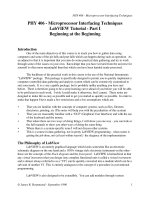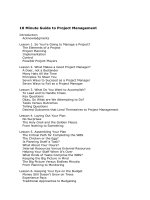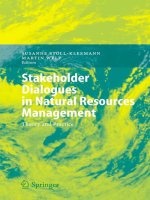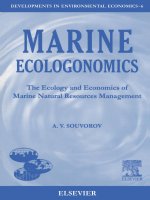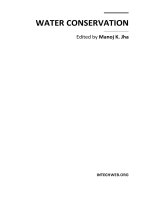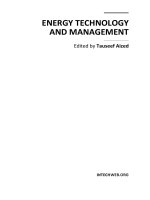Sustainable Natural Resources Management Part 1 docx
Bạn đang xem bản rút gọn của tài liệu. Xem và tải ngay bản đầy đủ của tài liệu tại đây (684.69 KB, 14 trang )
SUSTAINABLE NATURAL
RESOURCES MANAGEMENT
Edited by Abiud Kaswamila
Sustainable Natural Resources Management
Edited by Abiud Kaswamila
Published by InTech
Janeza Trdine 9, 51000 Rijeka, Croatia
Copyright © 2011 InTech
All chapters are Open Access distributed under the Creative Commons Attribution 3.0
license, which allows users to download, copy and build upon published articles even for
commercial purposes, as long as the author and publisher are properly credited, which
ensures maximum dissemination and a wider impact of our publications. After this work
has been published by InTech, authors have the right to republish it, in whole or part, in
any publication of which they are the author, and to make other personal use of the
work. Any republication, referencing or personal use of the work must explicitly identify
the original source.
As for readers, this license allows users to download, copy and build upon published
chapters even for commercial purposes, as long as the author and publisher are properly
credited, which ensures maximum dissemination and a wider impact of our publications.
Notice
Statements and opinions expressed in the chapters are these of the individual contributors
and not necessarily those of the editors or publisher. No responsibility is accepted for the
accuracy of information contained in the published chapters. The publisher assumes no
responsibility for any damage or injury to persons or property arising out of the use of any
materials, instructions, methods or ideas contained in the book.
Publishing Process Manager Gorana Scerbe
Technical Editor Teodora Smiljanic
Cover Designer InTech Design Team
Image Copyright WDG Photo, 2011. Used under license from Shutterstock.com
First published December, 2011
Printed in Croatia
A free online edition of this book is available at www.intechopen.com
Additional hard copies can be obtained from
Sustainable Natural Resources Management, Edited by Abiud Kaswamila
p. cm.
ISBN: 978-953-307-670-6
free online editions of InTech
Books and Journals can be found at
www.intechopen.com
Contents
Preface IX
Part 1 Application of Models, Remote Sensing and
GIS in Natural Resource Management 1
Chapter 1 Fuzzy Image Processing,
Analysis and Visualization Methods for
Hydro-Dams and Hydro-Sites Surveillance and Monitoring 3
Gordan Mihaela, Dancea Ovidiu, Cislariu Mihaela,
Stoian Ioan and Vlaicu Aurel
Chapter 2 Upstream Landscape Dynamics of
US National Parks with Implications for
Water Quality and Watershed Management 27
William B. Monahan and John E. Gross
Chapter 3 Sustainable Management of Large Scale
Irrigation Systems: A Decision Support Model
for Gediz Basin, Turkey 51
Murat Kilic and Suer Anac
Part 2 Climate Change Mitigation and Adaptation 83
Chapter 4 Sustainable Use of Natural Resources of
Dryland Regions in Controlling of
Environmental Degradation and Desertification 85
Peter F. Ffolliott
Part 3 Natural Resources Management and
Poverty Alleviation 103
Chapter 5 Sustainable Natural Resource Management,
a Global Challenge of This Century 105
Esmail Karamidehkordi
VI Contents
Chapter 6 Roles of Diverse Stakeholders in Natural Resources
Management and Their Relationships with
Regional Bodies in New South Wales, Australia 115
Brent C. Jacobs and Peter R. Brown
Chapter 7 An Analysis of the Contribution of Community Wildlife
Management Areas on Livelihood in Tanzania 139
Abiud Kaswamila
Chapter 8 Assessment of Livestock Loss Factors in
the Western Serengeti, Tanzania 155
J. W. Nyahongo and E. Røskaft
Preface
Archaeological evidence suggests that the earliest Neolithic resource users made their
decisions on resource use by selecting the best areas for different uses. Resource
management strategies have been influenced to varying extents by the nature of the
land ever since (Mango, 1996). Conscious land use planning, now worldwide
considered to be a panacea of resource use conflicts and a way of increasing
productivity, originated during the Greek empire when philosophers like Socrates,
Plato and Aristotle encouraged reasoning, logic, invention and scientific ways of
solving problems.
On the other hand, past and present efforts on land resources management seem to be
inadequate as land degradation, climate change, and demographic pressure continue
unabated and land productivity continues to decline at an alarming rate, which is
symptomatic of our failure to mitigate the problems. We now channel more than 40%
of terrestrial net primary productivity, which is sustenance of all animals and
decomposers, to our own needs (Vitousek et al., 1986). Forty-five percent is under
cropland and permanent pasture, 36% of Africa, 30% of North America, 35% of South
America, 47% of Europe, 25% of former Soviet Union (Woodroffe et al., 2005).
The current rate of land resources degradation worldwide is sending a shockwave
through mankind. Statistics show that soil erosion and other factors are leading to an
irreversible loss of land productivity on more than six million hectares of fertile land a
year - about 24% of the inhabited land (Lal, 1993). The values of individual continents
range from 12% in North America, 19% in Ocenia, 26% in Europe, 27% in Africa and
31% in Asia (Lal, 1993). Regardless of the methods used for the assessment, it is clear
that it is a worldwide problem requiring attention. For example, the Sub-Saharan
Africa imports about 10 million tons (60% of demand) of rice annually at a cost of
around US $ 6 billion, which is the largest continent’s import bill after petroleum
(Ngailo & Kaswamila, 2011). In other words, the need for natural resources
conservation is as great today as it ever was. Entering the 22
nd
Century, the challenges
to scientists, conservationists, politicians, planners, and decision-makers are to make
the world a safe place to live in, today and tomorrow, for the benefit of the present and
future generations. Our children and grandchildren should not ask us: why didn’t you
take action to safeguard our planet?
X Preface
This book is about finding the best way to manage challenges emanating from
accelerating natural resource use. The contributors in this book have vast expertise and
experience in natural resources management. All the chapters suggest that sustainable
natural resources management can only be achieved through use of system thinking to
help us think and learn collectively how to manage complexities and challenges. It
provides an integrated approach which finally creates an enabling environment for
stakeholders to adopt and benefit from; and adoption of resilience thinking as a
paradigm for systematic natural resource management planning process that offers
hope of transformational change in the management of socio-ecological systems. It is
also evident that technology use such as GIS and remote sensing and modelling have
great roles in natural resources management.
Abiud Kaswamila
Department of Geography and Environmental Studies
The University of Dodoma, Dodoma
Tanzania
Part 1
Application of Models, Remote Sensing and
GIS in Natural Resource Management
